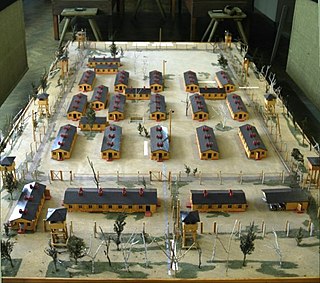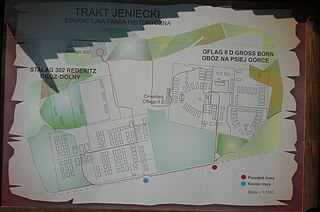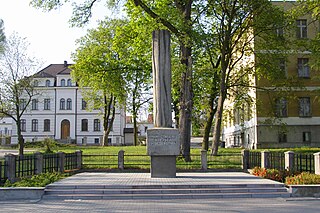
Stalag Luft III was a Luftwaffe-run prisoner-of-war (POW) camp during the Second World War, which held captured Western Allied air force personnel.

"The March" refers to a series of forced marches during the final stages of the Second World War in Europe. From a total of 257,000 western Allied prisoners of war held in German military prison camps, over 80,000 POWs were forced to march westward across Poland, Czechoslovakia, and Germany in extreme winter conditions, over about four months between January and April 1945. This series of events has been called various names: "The Great March West", "The Long March", "The Long Walk", "The Long Trek", "The Black March", "The Bread March", and "Death March Across Germany", but most survivors just called it "The March".

In Germany, stalag was a term used for prisoner-of-war camps. Stalag is a contraction of "Stammlager", itself short for Kriegsgefangenen-Mannschaftsstammlager, literally "main camp for enlisted prisoners of war". Therefore, "stalag" technically means "main camp".

Oflag II-D Gross Born (Grossborn-Westfalenhof) was a World War II German prisoner-of-war camp located at Gross Born, Pomerania, near Westfalenhof (Kłomino). It housed Polish and French officers.

Oflag XIII-B was a German Army World War II prisoner-of-war camp for officers (Offizierslager), originally in the Langwasser district of Nuremberg. In 1943 it was moved to a site 3 km (1.9 mi) south of the town of Hammelburg in Lower Franconia, Bavaria, Germany.

Stalag VIII-A was a German World War II prisoner-of-war camp, located just to the south of the town of Görlitz in Lower Silesia, east of the River Neisse. The location of the camp lies in today's Polish town of Zgorzelec, which lies over the river from Görlitz.

Stalag IV-B was one of the largest prisoner-of-war camps in Germany during World War II. Stalag is an abbreviation of the German Stammlager. It was located 8 km (5.0 mi) north-east of the town of Mühlberg in the Prussian Province of Saxony, just east of the Elbe river and about 30 mi (48 km) north of Dresden. From 1944 to 1945 it belonged to the Province of Halle-Merseburg. Now, the area is in Brandenburg. A sub-camp, sometimes identified as Stalag IV-B/Z,Stalag 304 or Stalag IV-H was located at Zeithain, 10 km (6.2 mi) to the south in Saxony.
Oflag VII-B was a World War II German prisoner-of-war camp for officers (Offizierlager), located in Eichstätt, Bavaria, about 100 km (62 mi) north of Munich.
Oflag X-B was a World War II German prisoner-of-war camp for officers (Offizierlager) located in Nienburg/Weser, Lower Saxony, in north-western Germany. Adjacent to it was the enlisted men's camp (Stammlager) Stalag X-C.

Stalag VII-A was the largest prisoner-of-war camp in Nazi Germany during World War II, located just north of the town of Moosburg in southern Bavaria. The camp covered an area of 35 hectares. It served also as a transit camp through which prisoners, including officers, were processed on their way to other camps. At some time during the war, prisoners from every nation fighting against Germany passed through it. At the time of its liberation on 29 April 1945, there were 76,248 prisoners in the main camp and 40,000 or more in Arbeitskommando working in factories, repairing railroads or on farms.

Camp Fünfeichen was a World War II German prisoner-of-war camp located in Fünfeichen, a former estate within the city limits of Neubrandenburg, Mecklenburg, northern Germany. Built as Stalag II-A Neubrandenburg in 1939, it was extended by the officer camp Oflag II-E in 1940. After the Soviet takeover in 1945 until 1949 it was used as special camp, NKVD-camp Nr. 9 of the Soviet secret service (NKVD). Today, the site of the camp is a memorial.
Oflag XIII-A, Oflag XIII-B and Oflag XIII-D were all German World War II prisoner-of-war camp for officers (Offizierlager). They were all located on the old Nazi party rally grounds in Langwasser, Nuremberg, in northern Bavaria. They were adjacent to Stalag XIII-D.
Stalag XIII-C was a German Army World War II prisoner-of-war camp (Stammlager) built on what had been the training camp at Hammelburg, Lower Franconia, Bavaria, Germany.

Oflag XXI-B and Stalag XXI-B were World War II German prisoner-of-war camps for officers and enlisted men, located at Szubin a few miles southwest of Bydgoszcz, Poland, which at that time was occupied by Nazi Germany.

Oflag XXI-C was a German Army World War II prisoner-of-war camp for officers (Offizierlager) located in Ostrzeszów in German-occupied Poland. It held mostly Norwegian officers arrested in 1942 and 1943, but also Dutch, Italian, Serbian and Soviet POWs. Originally most Norwegian soldiers and officers had been released after the end of the Norwegian campaign, but as resistance activities increased, the officers were rearrested and sent to POW camps.

Hohenfels is a municipality in the district of Neumarkt in the region of Upper Palatinate in Bavaria, Germany. The town is host to the United States Army Garrison Hohenfels, which operates the Joint Multinational Readiness Center for training of North Atlantic Treaty Organization (NATO) armed forces.
Stalag Luft I was a German World War II prisoner-of-war (POW) camp near Barth, Western Pomerania, Germany, for captured Allied airmen. The presence of the prison camp is said to have shielded the town of Barth from Allied bombing. About 9,000 airmen – 7,588 American and 1,351 British and Canadian – were imprisoned there when it was liberated on the night of 30 April 1945 by Soviet troops.
Machiel van den Heuvel was a Dutch army officer. As a prisoner-of-war in Oflag IV-C at Colditz Castle, Germany, during World War II, he served as Escape Officer for the Dutch POWs, a role also held by Captain Pat Reid, the author of The Colditz Story, for the British. Van den Heuvel played a key role in most Dutch officer escapes during the war.

Stalag XXI-D was a German World War II prisoner-of-war camp based in Poznań in German-occupied Poland, operated in 1940–1945. It held Polish, French, British, Belgian, Dutch, Serbian, Soviet and Italian POWs.

Nazi Germany operated around 1,000 prisoner-of-war camps during World War II (1939-1945).














